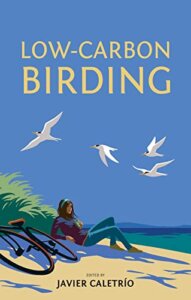 Reading and reviewing (click here) the new book, Low -carbon birding, and particularly the contribution from Nick Moran, made me review my Birdtrack records to reflect on my travel as a birder in the UK.
Reading and reviewing (click here) the new book, Low -carbon birding, and particularly the contribution from Nick Moran, made me review my Birdtrack records to reflect on my travel as a birder in the UK.
Birdtrack (click here) is a way of keeping your bird sightings in one place where they can be reviewed and interrogated by yourself but where they are also available to the BTO and RSPB (and others) to analyse alongside thousands of other birders’ records.
I am a fairly assiduous user of Birdtrack – when I am birding, I make a complete list of the bird species I see on that visit, in real time on my mobile phone and they head into Birdtrack at the end of the day. But I am always alive to the possibility of seeing birds so when I am in London for other reasons, or at a racecourse for distinctly different reasons, or at a friend’s house, or at a railway station, I might well make a record of the birds I see there in that 20 minutes, or half a day or whatever. These are bird records but they can’t really be regarded as places I went to, adding to my carbon footprint, for the purpose of birding.
Reviewing my records in this frame of mind encouraged me to do some house-keeping of my records; I renamed some sites, I merged some sites together, I edited the boundaries of some of the sites and I deleted just a few records as being of little interest to me and of no interest to anybody else. I was left with around 2000 lists (mostly but not all complete lists for the visit) spread over the past 18 years, which means that I am recording birds on about a third of all days. I’m quite surprised it is that high even though I know that I’m alive to the possibility of seeing birds every minute of my life.
Well over half of my birding records are from Northamptonshire and just about half are from just two sites: my local patch of Stanwick Lakes and my own home and garden. Of the rest, there are about 4% from racecourses, especially Cheltenham. Some are, I can see, from work as this period takes me back through the period when I was the RSPB Conservation Director which means there are lists from The Lodge where I was based, and from various localities, many of them RSPB nature reserves, to which I travelled in the course of work.
Most of the rest are day trips from home to places like Rainham Marshes, Gibraltar Point, Minsmere and North Norfolk, and the fruits of family holidays. Almost all of the travel involved in my birding is by car – there’s no getting away from that, indeed there’s not much getting anywhere with the state of public transport and the location of many birding hotspots, or warm spots, without it being by car. If instead of nipping down to Stanwick Lakes I had nipped along to Summer Leys each time my carbon footprint for a quarter of my birding would have been roughly five times higher (but I’d have seen a few more birds probably). But then, if I had never gone birding at all it would have been zero.
I found this window into my birding interesting for many reasons. For a start it reminded me of birds seen, places visited and people with whom I saw those birds and places. But it also brought home to me how much of my birding is done at nature reserves. If the likes of Slimbridge, Spurn, Cley, Minsmere, Titchwell and Rainham Marshes didn’t exist, as nature reserves, my birding would be so much poorer. And it told me something of my travel for birding although it would take a more sophisticated analysis for that to be very meaningful. I am tempted to call myself a lowish-carbon birder on the basis of the fact that most of my birding is very local and much of the rest of it is pretty local, but I’d be interested to see comparisons with others.
I am tempted to work out how much of my birding, at least as revealed by Birdtrack records, has been done within 5, 20 and 100 miles of home (which hasn’t moved during the period) but that would be a bit of a chore. Still, on some rainy weekend in the future I might take it further.
But then, what about my birding abroad? To be continued…
[registration_form]